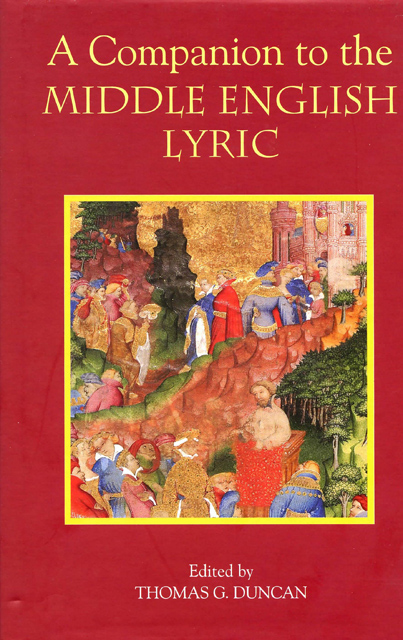Book contents
- Frontmatter
- Contents
- Acknowledgements
- Abbreviations
- Editorial Note
- Introduction
- 1 Middle English Lyrics and Manuscripts
- 2 Middle English Lyrics: Metre and Editorial Practice
- 3 The Love Lyric before Chaucer
- 4 Moral and Penitential Lyrics
- 5 Middle English Religious Lyrics
- 6 Middle English Courtly Lyrics: Chaucer to Henry VIII
- 7 The Middle English Carol
- 8 Political Lyrics
- 9 The Lyric in the Sermon
- 10 ‘Cuius Contrarium’: Middle English Popular Lyrics
- 11 Gender and Voice in Middle English Religious Lyrics
- 12 Lyrics in Middle Scots
- Bibliography of works cited
- Index of Manuscripts Cited
- General Index
- Index of Lyrics
11 - Gender and Voice in Middle English Religious Lyrics
Published online by Cambridge University Press: 23 March 2023
- Frontmatter
- Contents
- Acknowledgements
- Abbreviations
- Editorial Note
- Introduction
- 1 Middle English Lyrics and Manuscripts
- 2 Middle English Lyrics: Metre and Editorial Practice
- 3 The Love Lyric before Chaucer
- 4 Moral and Penitential Lyrics
- 5 Middle English Religious Lyrics
- 6 Middle English Courtly Lyrics: Chaucer to Henry VIII
- 7 The Middle English Carol
- 8 Political Lyrics
- 9 The Lyric in the Sermon
- 10 ‘Cuius Contrarium’: Middle English Popular Lyrics
- 11 Gender and Voice in Middle English Religious Lyrics
- 12 Lyrics in Middle Scots
- Bibliography of works cited
- Index of Manuscripts Cited
- General Index
- Index of Lyrics
Summary
In Middle English lyric poetry, most of which is anonymous, only a few fragments and poems can be can be identified as the work of named women poets. One of these is a Hymn to Venus, attributed in its single manuscript to ‘Queen Elizabeth’, probably Elizabeth Woodville, the wife of Edward IV. Another is a hymn to the Virgin described by the scribe John Shirley as being by an holy Ankaresse of Maunsffeld. Yet another is also a poem in praise of the Virgin described in its manuscript as the prayer (oratio) of Eleanor Percy (Barratt 1992, 262–3; 275–81). Thus, of the sizable corpus of Middle English lyrics extant today, only three poems, all from the fifteenth and early sixteenth centuries, have been identified as the work of specific female writers. With other lyrics, assumptions we might make about the gender of the poet rest with voicing, subject matter, or the cluster of inferences and implications we might call attitude. As Sarah McNamer has convincingly argued, some of the poems in the late fifteenthcentury Findern manuscript may be the work of female poets. This judgment is based on evidence in the manuscript that women from prominent local families copied the poems, on the large number of unique poems in this manuscript, on the voicing of some of the lyrics from a woman's point of view, and on the approach taken to the subject of these lyrics which, in all cases, is love (McNamer 1991, 279–302). It is also possible that women may have written a number of the extant devotional poems. Alexandra Barratt suggests that some lyrics in which the Virgin laments the death of her son and lyrics of the Passion might have been the work of female poets (Barratt 1992, 262). In the case of these devotional poems, as with the love lyrics of the Findern manuscript, speculations about the gender of the poet are based on style, subject matter, and point of view: there is no hard evidence to tell us whether they were written by men or women.
In a search for the poet behind the words in the manuscript, we might expect the point of view of the poem's speaker to give us the best evidence.
- Type
- Chapter
- Information
- A Companion to the Middle English Lyric , pp. 227 - 241Publisher: Boydell & BrewerPrint publication year: 2005



